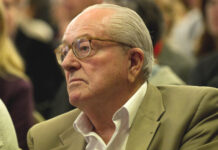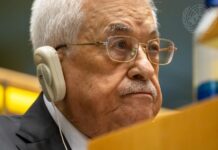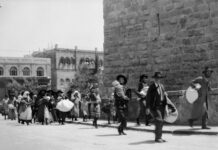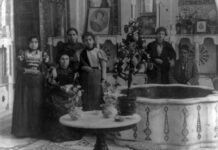It’s one of the few rap videos around that features a lead singer in frockcoat, tallis and shtreimel—paired with a cascade of gold chains (one bearing a Magen David) and leopard-skin scarf—dancing with guys from the ‘hood facing off against others in Chassidic garb.
As such, “Mothaland Bounce,” where our hero proudly calls himself “Hitler’s worst nightmare,” reveals much about the man behind it and what it means to be a passionate and deeply committed Jew of color.
Because for Nissim Black—successful rapper, father of six and Orthodox Jew—the video makes a strong statement about how Jews of color merge their very disparate identities into a (nearly) seamless whole.
(Fans may want to check out Black’s newest rap video “Hava”—a thoroughly Nissim spin on the traditional “Hava Nagila”—its release timed for the first night of Hanukkah).
Though the term itself has gained traction in the last decade, there have always been Jews of different races. Scan the globe today, and you’ll find Ethiopian Jews and the African Lemba tribe whose men test positive for the Kohen gene, a marker of the Jewish priests.
What’s more, many Sephardic, Cuban, Mexican and Yemenite Jews consider themselves Jews of color. Not to mention the murky waters surrounding pockets of the Black Hebrews found in Israel (largely in Dimona and Arad in the Negev Desert) and around the Diaspora, many of whom claim descent from the ancient Israelites.

The numbers are equally murky. Estimates range from 6 percent to 12 percent—or even as much as 15 percent—of today’s Jewish population being Jews of color. But there is little in the way of standardized definition of who is a Jew; some studies count all the members of a household as Jewish household when only one member actually is. But when researchers Arnold Dashefsky and Ira M. Sheskin held the disparate estimates of Jews of color up to the light of demographic standards earlier this year, they concluded that the percentage of Jews of color “is almost certainly closer to 6 percent nationally [from the 2013 Pew study] than 12 to 15 percent. And this percentage has not increased significantly since 1990, although it is likely to do so in the future.”
It stands to reason that this year of painful racial tensions across North America could trigger an internal debate in African-American Jews, especially those who came to the faith not through birth or adoption, but who, like Black, embraced Judaism as adults.
And embrace it many of them do—with passion, perseverance and a deep appreciation—often overcoming raised eyebrows, insensitivity and even downright racism in the process. With a surprising number of them finding their spiritual home in Orthodox Judaism.
Nissim Black
Damian Jamohl Black, whom the world knows now as rapper Nissim Black, was born into a family of Seattle drug dealers in 1986. His childhood was pockmarked by FBI raids on his home, his dad was taken away in handcuffs, and he was accustomed to assorted incidents of street violence and crime. By 9, he was smoking marijuana, and plants were growing in his room. By 12, he’d joined the family business.

The only faith Black was exposed to back then was his grandfather’s Islam. His first religious service? A mosque, which he attended until his grandfather went to prison.
But at 13, Black was pulled into Christianity by missionaries. He now says it was the best thing that could have happened to him. “This was the first time I was around people who had normal healthy relationships. No one sold drugs, they had a heart for kids from the inner city, and their summer camp was the most fun I’d had in my life,” he recalls. “Becoming religious saved me from the world of street gangs.”
By high school, he was “the poster child of the missionary center.” That’s when he met the woman who would become his wife. As a Seventh-Day Adventist, Jamie (now Adina) went to church on Saturdays. They wed in 2008 but remarried in an Orthodox ceremony after their conversion five years later.
By 19, Black was making rap music professionally, and his mother died of an overdose. But by 20, Christianity was beginning to feel foreign to him, and he began wondering what the Jews walking in his neighborhood on Saturday mornings were up to. “I went to Rabbi Google and found Chabad.org. And it all began to make sense,” he says. “I told my wife [they were newlyweds] that I didn’t want to celebrate Christmas and Easter anymore. Pretty soon, she was doing her own digging into Judaism.”
The couple’s conversion followed in 2013 and aliyah to Israel three years later. The Blacks now make their home in Ramat Beit Shemesh with their six children, ages 1 to 12. “I wanted my kids to grow up here,” he says, “where they’d see Jews of different shades all praying the same prayers.”

“I’ve checked every box, right?” he says with a laugh. “One rabbi at my yeshivah told me, ‘You have a lot of strikes against you: You’re black, you’re a convert and you’re a Breslov Chassid. And in all these things is your greatness.”
Maayan Zik
Maayan Zik was 13 when her soul woke her up. Growing up in Washington, D.C., with her mom and sister—her parents divorced when she was in first grade, and she didn’t see her dad for another 10 years—she attended Catholic schools and was close with her maternal grandparents, Jamaican immigrants who took her to museums and taught her the value of hard work and education.
Accompanying her Jamaican-born grandmother to church every Sunday, by 13, Zik had “begun to wonder if what my family believes is right for me.” She explored a number of world religions, but when she saw a photo of her light-skinned Jamaican great-grandmother Lilla Abrams, whom family lore says was Jewish, “I realized I had to go way back to find out who I am.”

When she moved to an apartment in 2005 in the Crown Heights neighborhood of Brooklyn, N.Y., she noticed the previous tenant had a left up a poster of a white-bearded man. “I said to myself, ‘I’m going to find out who you are.’ The man turned out to be the Lubavitcher Rebbe. Two years later, after courses and a summer seminary program, she converted. Thirteen years later, now 36, Zik remains there—with her Israeli-born husband and four children. “This somewhat awkward coexistence that lives inside me” fades into the background when she begins to pray, she says. “Having a personal conversation with God as part of the Jewish people, it’s who I’ve always been; I just didn’t know it.”
Mordechai Ben Avraham
Black and Mordechai Ben Avraham are both African-Americans from the West Coast (Seattle and Los Angeles, respectively), and both found Judaism in their 20s. But their early environment could hardly have been more different.
Growing up in an affluent neighborhood with a successful businessman father and a professor mother, “my focus was on how someday I could make more money than my dad.”
Ben Avraham’s spiritual journey took him from Sufism to the Kabbalah until at 22 he experienced Shabbat in a Carlebach-style minyan. “It was like I was floating in outer space. This is what Jews do? This is amazing! The Torah, the prayers, this beautiful spiritual system God gave to the Jews for people to transform themselves—they literally grabbed my heart.” His conversion was complete in 2013 with his move to Israel three years later.
Now 39, the former TV producer is living in the heart of Jerusalem’s religious Mea Shearim neighborhood, working towards his rabbinical degree and publishing a book on the joys of Torah as a black Jew.
But why would anyone who’s already making a huge leap religiously and culturally choose to embrace Orthodoxy with its full menu of mitzvot, accepting the Torah as Divine and committing to living within halachah (Jewish law)?
“If someone is going to make this big of a change completely based on their need to go beyond, there’s a very real tendency to go what many would consider ‘all the way,’ ” says Henry Abramson, dean of Brooklyn’s Touro College and author of The Kabbalah of Forgiveness: The Thirteen Levels of Mercy in Rabbi Moshe Cordovero’s Date Palm of Devorah (2014), among other titles.
A shared history
Much of this tendency to search spiritually can be traced to African-Americans’ religious experience in America, adds Abramson. “Since the 1960s, we’ve seen the phenomenon of questioning the Christianity foisted on their slave ancestors.”
And though Islam has attracted many of these disenfranchised souls—in part, he says, because the black Muslim culture permeated prisons beginning in the 1960s—Judaism offers another option.
Ben Avraham maintains that, in a spiritual sense, Judaism may feel familiar to those raised in the black church. “Like Judaism, gospel Christianity is an intense personal relationship with God without any intermediaries,” he says.
This is a connection Ben Avraham experiences every day of his life. “Living in Mea Shearim, in a fundamental way, I’m around people who are just like me. I just connect with my Chassidic neighbors.”
A growing fissure
But after the 1960s and ’70s, when Jews fought alongside blacks for civil rights in the United States and in South Africa, “there’s been a growing fissure between blacks and Jews,” says Rabbi Maury Kelman who, as director of Route 613, a New York City conversion program, has welcomed many students of different races into his classes.
And, with last summer’s rise in violence between the African-American community and the religious Jewish community, primarily in New York,” says Black, “lately, it’s gotten uglier.”

‘I cried all the way home’
Not everyone in the Jewish community rolls out the proverbial red carpet for someone of color.
After working up the courage to walk into synagogue on Shabbat, Zik couldn’t miss the two women glaring at her, eventually yelling at her to get out and threatening to call the police before giving chase.
“I cried all the way home, but my friends would not let me give up,” she says. “I also knew from everything I’d read about the Rebbe, with his emphasis on love and kindness, that eventually this would be the right place for me.”
“Unfortunately, like in all communities, you’ll find the occasional ignorant Jew or racist,” allows Kelman, who offers programs on the importance of accepting the convert.
A time of racial tensions
With this year’s heated racial debates and demonstrations following the May 25 killing of George Floyd in Minneapolis, where does that put Jews of color, with feet in both the African-American and Jewish worlds?
Zik, for one, helped lead a rally in Crown Heights this summer where black neighbors shared their experiences with racism. “It was a reminder,” she says, “that the Torah teaches us to protect the rights of all God’s children.”
And the learning goes both ways, she adds. “When black friends ask me if now that I’m Jewish, do I have money? I tell them about the Jews I know who struggle to pay for rent, food and their kids’ yeshivah tuitions. I tell them that, when I’ve had my babies, neighbors bring us meals and help furnish the nursery. People here always want to do another mitzvah.”

Ben Avraham also says he better appreciates African-American history because he is a Jew. “We can see our own story reflected in the Torah,” he says. “Our two peoples had so many struggles just to survive.”
Adds Black: “Just knowing there are black religious Jews can help the two communities see they aren’t completely separate after all—not to judge each other so quickly.”
Kelman agrees. “Black Jews can be a terrific bridge chiefly because they have credibility on both sides. It’s increasingly important to teach our fellow Jews that we’re a family that comes in different colors, that Judaism is colorblind,” he says. “Once they convert, they’re just as Jewish as any of us—and our diversity only strengthens us.”
‘Something bigger than myself’
By the end of “Mothaland Bounce,” the guys from the ’hood and the Chassids are dancing together with Black as ringmaster.
But it may be “A Million Years” that’s Black’s love letter to Judaism.
In this 2016 music video (with singer Yisroel Laub), Black takes a journey proudly carrying a Torah throughout Israel—archeological digs, mountain caves, a busy shuk (marketplace) and Jerusalem’s Old City—turning heads as he goes. (Don’t miss the moment when Black stops to let some haredi kids lovingly kiss the Torah), finally nestling it inside a synagogue’s ark.
“Since I was a kid, I was looking to be part of something bigger than myself,” says Black. “I prayed and prayed, and finally, I knew who I needed to be, a Jew, and where I needed to be, the Holy Land. It took time but now God’s answered my prayers. And one thing I know is that to God there is no such thing as color. He sees us for who we are inside.”
As he raps:
“I came from a distance
Where everything was different …
I called out to You
And You showed me that You listened …
I gave my all to You
And You showed me who I am.”

























